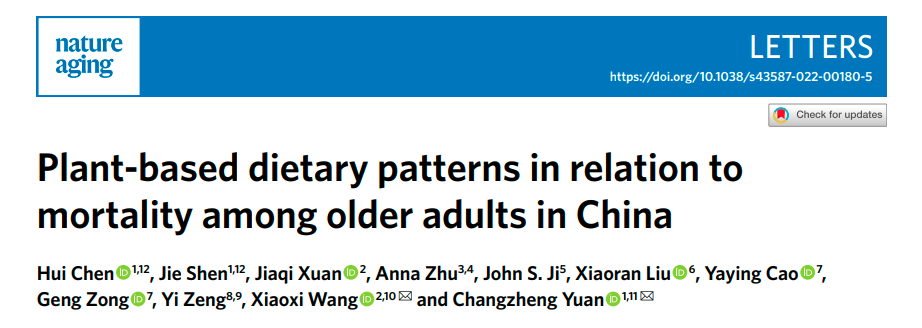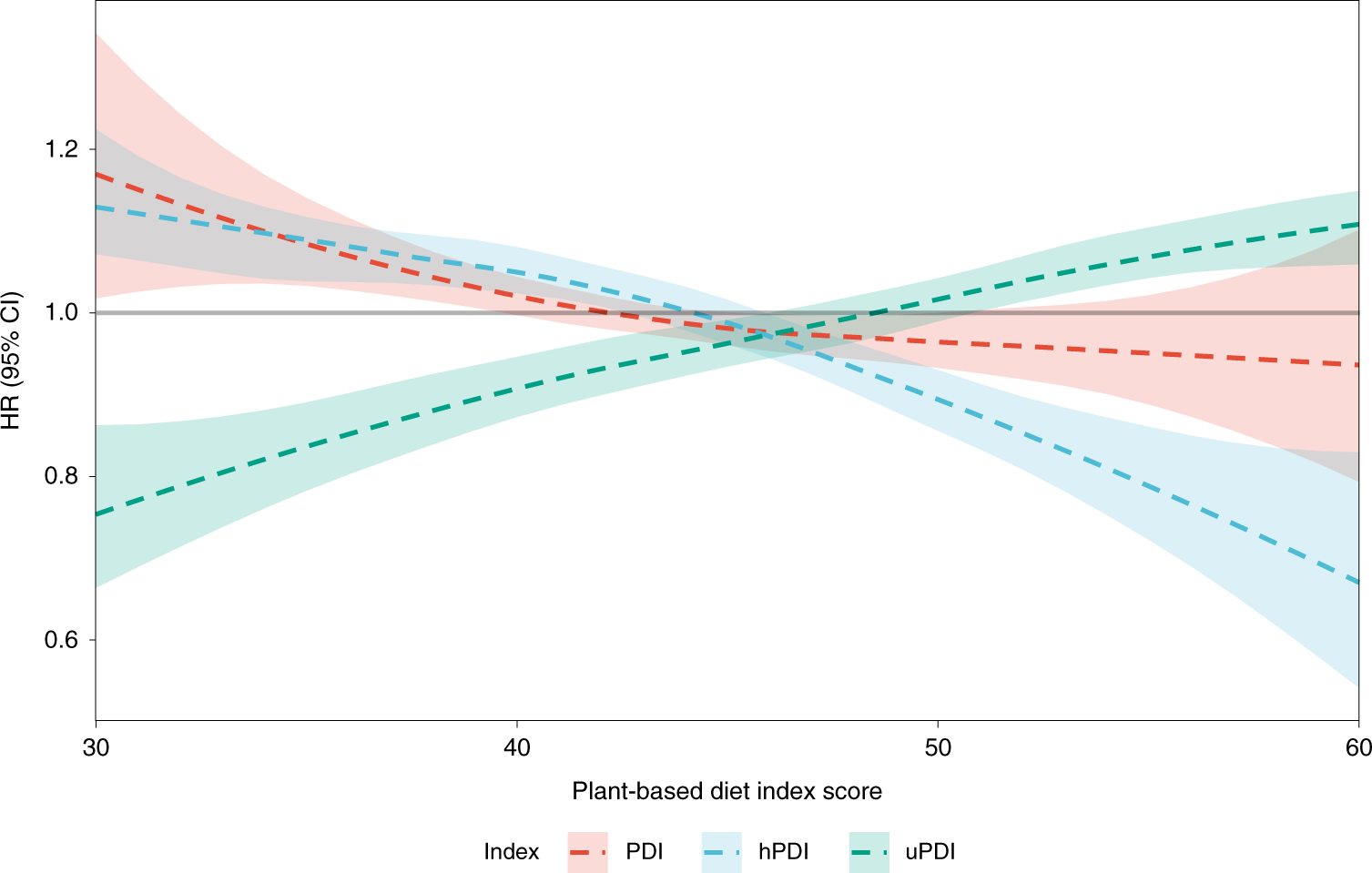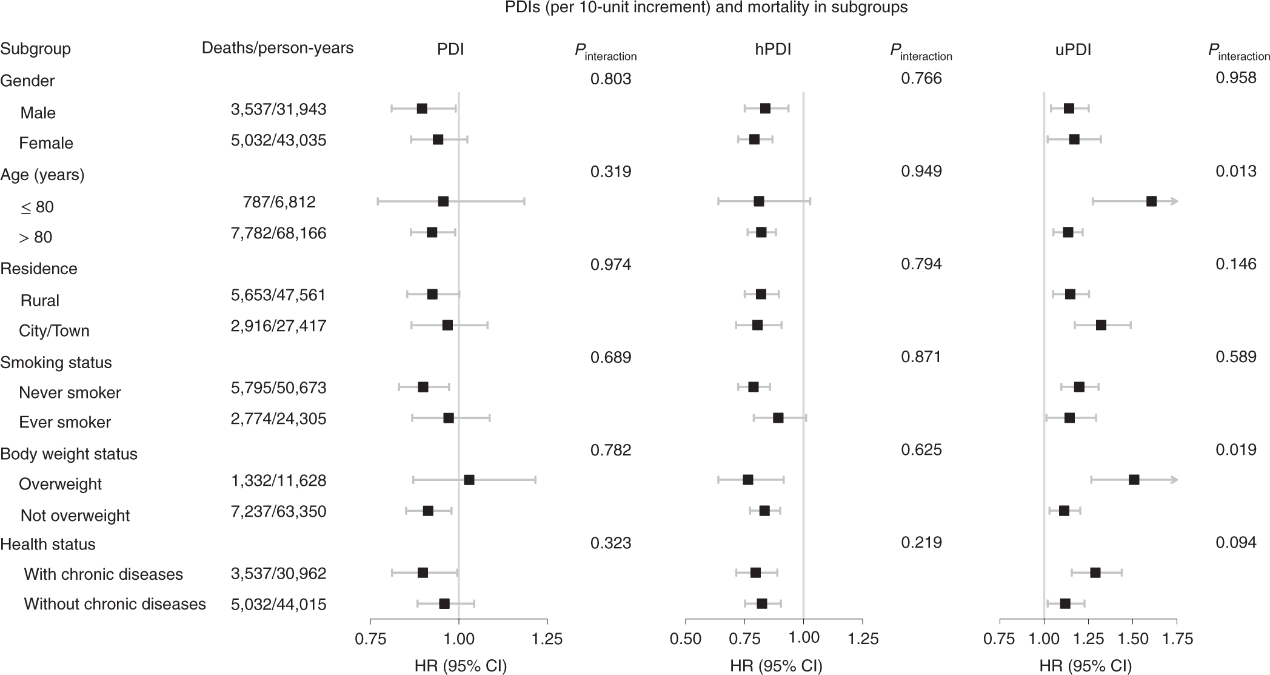近日,浙江大学中国农村发展研究院“百人计划研究员”汪笑溪课题组与公共卫生学院“百人计划研究员”袁长征课题组合作撰写的论文“Plant-based dietary patterns in relation to mortality among older adults in China”于2022年3月7日在Nature Aging上发表。该研究基于中国纵向健康长寿调查(CLHLS),为中国老年人群植物性饮食模式与死亡的前瞻性关联提供科学依据。

植物性饮食模式(强调以自然植物源性食物为主,少量摄入动物源性食物)因其对健康和环境的潜在双重益处而受到广泛关注和推荐。在少量摄入动物源性食物的基础上进一步对植物性食物分类,健康植物性饮食更倾向于新鲜蔬菜、坚果等健康的植物源性食物;而不健康的植物性饮食则更倾向于腌制蔬菜、糖等不健康的植物源性食物。既往关于植物性饮食与疾病、死亡风险的研究多基于西方人群,且缺乏对植物性饮食进行统一的定义、测度与分类。植物性饮食是否有利于中国人群健康,不同类型的植物性饮食模式与死亡的关联仍有待深入探究。

基于中国纵向健康长寿调查(CLHLS)中13,154名老年人的膳食问卷调查结果,本研究计算了整体植物性饮食指数(PDI)、健康植物性饮食指数(hPDI)和不健康植物性饮食指数(uPDI),进而分析不同的植物性饮食模式与死亡风险的关联。研究发现,整体植物性饮食模式与较低的死亡风险相关(HR Q5 versus Q1 = 0.92, 95% CI: 0.86–0.98),健康植物性饮食模式则与更低的死亡风险相关(HR Q5 versus Q1 = 0.81, 95% CI: 0.76–0.87),而不健康的植物性饮食模式将带来死亡风险的上升(HR Q5 versus Q1 = 1.17, 95% CI: 1.09–1.26)。

从不同人群亚组的结果来看,对于80岁及以下人群和超重人群,不健康的植物性饮食模式将极大程度上增加其死亡风险。从不同类别的植物性食物来看,新鲜水果、新鲜蔬菜、豆类、大蒜、坚果和茶是主要的保护因素,而腌制蔬菜和糖的过多摄入将增加死亡风险。本研究为整体和健康植物性饮食模式对老年人群长寿的积极作用提供了依据,并发现了不健康的植物性饮食模式对老年人群健康的潜在威胁。基于研究结果,本研究强调关注植物性饮食质量的必要性。
英文摘要
Abstract:
A plant-based dietary pattern has been recommended for its potential health and environmental benefits, but its relation to mortality warrants further exploration. We examined this association among 13,154 adults aged 65 years and older (57.4% female) in the Chinese Longitudinal Healthy Longevity Survey (CLHLS). The overall plant-based diet index (PDI), healthful plant-based diet index (hPDI) and unhealthful plant-based diet index (uPDI) were calculated using dietary data collected by a simplified food frequency questionnaire (FFQ). Compared with the lowest quintile, participants in the highest quintile of PDI and hPDI had a decreased risk of all-cause mortality (hazard ratio (HR) = 0.92; 95% confidence interval (CI) 0.86, 0.98 for PDI; HR = 0.81, 95% CI, 0.76, 0.87 for hPDI), whereas participants with the highest uPDI scores had a 17% (95% CI, 9%, 26%) increased risk. Among plant foods, fresh fruits, fresh vegetables, legumes, garlic, nuts and tea were the main protective contributors, whereas preserved vegetables and sugar were associated with a higher risk of mortality. These findings support the beneficial roles of overall and healthful plant-based dietary patterns. The quality, and not only quantity, of plant foods should be emphasized in relevant public health recommendations.
Chen, H., Shen, J., Xuan, J., Zhu, A., Ji, J.S., Liu, X., Cao, Y., Zong, G., Zeng, Y., Wang, X., Yuan, C., 2022. Plant-based dietary patterns in relation to mortality among older adults in China. Nat Aging 1–7. https://doi.org/10.1038/s43587-022-00180-5
原文链接:https://www.nature.com/articles/s43587-022-00180-5
作者简介:
汪笑溪(共同通讯作者)

汪笑溪,柏林洪堡大学农业经济学博士,浙江大学“百人计划”研究员、博士生导师,现任教于浙江大学公共管理学院农业经济与管理系、浙江大学中国农村发展研究院(CARD),同时兼任德国波茨坦气候影响研究所(PIK)客座高级科学家,担任World Development执行编辑。曾长期任职于德国波茨坦气候影响研究所(PIK),参与开发了国际知名的农业经济土地利用模型MAgPIE。其研究主要关注食物系统、综合评估模型、气候变化影响及减缓政策等领域。其研究成果发表于Nature Aging,Lancet Regional Health,Ecological Economics,World Development,Nature Sustainability,Technological Forecasting and Social Change等国际权威期刊。
袁长征(共同通讯作者)

袁长征,哈佛大学陈曾熙公共卫生学院营养学和流行病学博士,浙江大学“百人计划”研究员、博士生导师,现任教于浙江大学公共卫生学院,同时任哈佛大学陈曾熙公共卫生学院兼职助理教授。其研究主要集中于膳食营养、生活方式与健康老龄化及老年认知衰退发生发展的关系。主持多项国家级、省级及国际基金项目。 其研究成果在Nature Aging,Lancet Regional Health,American Journal of Epidemiology,Neurology,JAMA Pediatrics等国际权威期刊发表70余篇文章。


